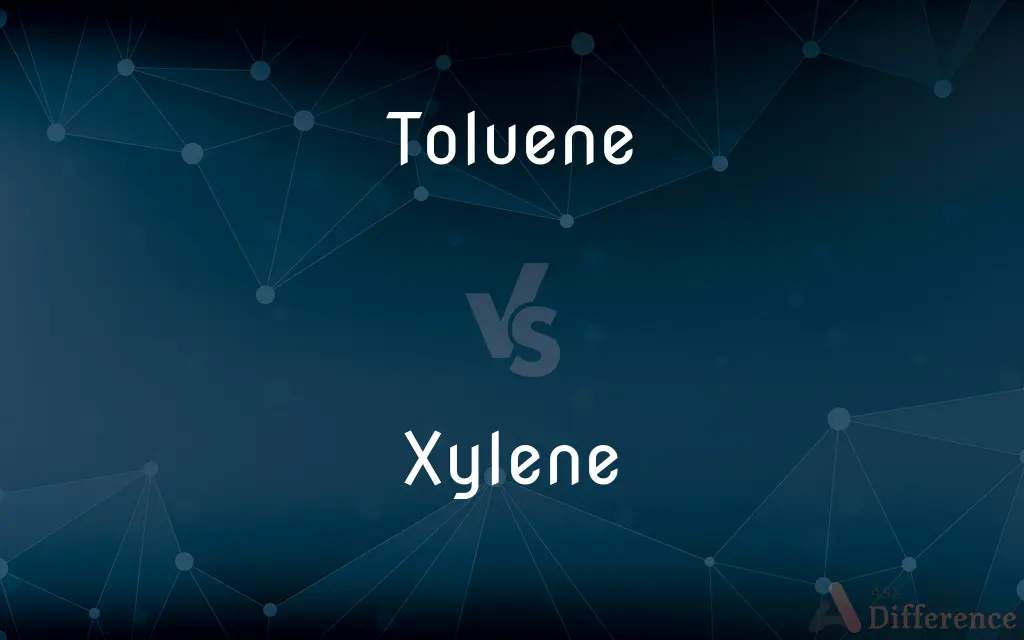Toluene vs. Xylene — What's the Difference?
Edited by Tayyaba Rehman — By Fiza Rafique — Updated on September 30, 2023
Toluene is a monosubstituted benzene derivative while Xylene consists of three isomers, all dimethylbenzenes. Both are volatile, flammable organic solvents.

Difference Between Toluene and Xylene
Table of Contents
ADVERTISEMENT
Key Differences
Toluene and Xylene are both aromatic hydrocarbons derived from benzene and are utilized extensively as solvents in various industries. Toluene, also known as methylbenzene, has a single methyl group attached to a benzene ring. Xylene, however, encompasses three isomers (ortho-, meta-, and para-xylene) with two methyl groups on the benzene ring.
In industrial applications, Toluene serves as a solvent in products like paints, rubber, resins, and adhesives due to its ability to dissolve a wide range of organic compounds. Xylene, sharing some applications with Toluene, is also found in the production of petrochemicals and is used for thinning paints and varnishes.
From a health standpoint, both Toluene and Xylene can be harmful if inhaled, ingested, or absorbed through the skin in large amounts. While Toluene exposure can affect the central nervous system, Xylene exposure might result in symptoms such as headache, dizziness, and nausea.
In summary, while both Toluene and Xylene are crucial in industrial applications and share the aromatic hydrocarbon lineage, their molecular structures and consequent properties differ, with Toluene having a single methyl substitution and Xylene having two.
Comparison Chart
Molecular Structure
Monosubstituted benzene
Dimethylbenzenes (three isomers)
ADVERTISEMENT
Common Use
Solvent in paints, rubber
Thinning paints, petrochemical production
Number of Isomers
1
3 (ortho-, meta-, para-xylene)
Health Effects
Affects central nervous system
Causes headache, dizziness, nausea
Chemical Reactivity
Reacts based on one methyl group
Reacts based on position of two methyl groups
Compare with Definitions
Toluene
An aromatic hydrocarbon with one methyl group.
They used Toluene to dissolve the adhesive.
Xylene
An aromatic compound with three isomers and two methyl groups.
The sample contained a mix of Xylene isomers.
Toluene
A clear, water-insoluble liquid with a pungent smell.
The lab was filled with the unmistakable odor of Toluene.
Xylene
A solvent in the printing, rubber, and leather industries.
They utilized Xylene to clean the printing equipment.
Toluene
A derivative of benzene with a CH₃ substitution.
Toluene differs from benzene by just a methyl group.
Xylene
Often found in small amounts in airplane fuel and gasoline.
The fuel composition included a percentage of Xylene.
Toluene
A common solvent in paints, rubber, and resins.
Toluene ensures the paint spreads evenly on the wall.
Xylene
Clear, flammable liquid with a sweet odor.
The container was labeled as containing Xylene and was kept away from flames.
Toluene
Used in the production of TNT and pharmaceuticals.
They synthesized the drug using Toluene as an intermediate.
Xylene
Used in the production of petrochemicals and plastics.
Xylene is crucial in making certain plastic items.
Toluene
Toluene (), also known as toluol (), is an aromatic hydrocarbon. It is a colorless, water-insoluble liquid with the smell associated with paint thinners.
Xylene
Xylene (from Greek ξύλον xylon, "wood"), xylol or dimethylbenzene is any one of three isomers of dimethylbenzene, or a combination thereof. With the formula (CH3)2C6H4, in each of the three compounds a benzene ring is substituted by two methyl groups.
Toluene
A colorless flammable aromatic liquid, C7H8, obtained from coal tar or petroleum and used in aviation fuel and other high-octane fuels, in dyestuffs, explosives, and as a solvent for gums and lacquers. Also called methylbenzene.
Xylene
Any of three colorless flammable isomeric benzene derivatives, C8H10, obtained from wood and coal tar.
Toluene
(organic compound) A colourless, inflammable liquid hydrocarbon, methylbenzene, CH3.C6H5, used as a solvent, in high-octane fuels and in the production of many chemical compounds.
Xylene
A mixture of xylene isomers used as a solvent in making lacquers and rubber cement and as an aviation fuel.
Toluene
A hydrocarbon, C6H5.CH3, of the aromatic series, homologous with benzene, and obtained as a light mobile colorless liquid, by distilling tolu balsam, coal tar, etc.; - called also methyl benzene, phenyl methane, etc.
Xylene
(chemistry) Any of a group of three isomeric aromatic hydrocarbons, found in coal and wood tar.
Toluene
A colorless flammable liquid obtained from petroleum or coal tar; used as a solvent for gums and lacquers and in high-octane fuels
Xylene
Any of a group of three metameric hydrocarbons of the aromatic series, found in coal and wood tar, and so named because found in crude wood spirit. They are colorless, oily, inflammable liquids, C6H4.(CH3)2, being dimethyl benzenes, and are called respectively orthoxylene, metaxylene, and paraxylene. Called also xylol.
Xylene
A colorless flammable volatile liquid hydrocarbon used as a solvent
Common Curiosities
Can Toluene be used as a paint thinner?
Yes, Toluene is commonly used in paints and can act as a thinner.
Which compound is used in the rubber industry?
Both Toluene and Xylene are used in the rubber industry, but Toluene is more prevalent.
In which industries is Xylene most commonly used?
Xylene is widely used in the printing, rubber, and leather industries as a solvent.
Is Toluene more reactive than Xylene?
Reactivity varies based on conditions, but Toluene's single methyl group gives it distinct behaviors compared to Xylene.
Are Toluene and Xylene derived from benzene?
Yes, Toluene is a monosubstituted benzene, and Xylene is a dimethylbenzene derivative.
How many isomers does Xylene have?
Xylene has three isomers: ortho-, meta-, and para-xylene.
Can Xylene exposure cause dizziness?
Yes, inhaling Xylene can lead to symptoms like dizziness and nausea.
Are both Toluene and Xylene flammable?
Yes, both Toluene and Xylene are flammable organic solvents.
Is Toluene a clear liquid?
Yes, Toluene is a clear, water-insoluble liquid with a pungent smell.
Share Your Discovery

Previous Comparison
Reorganize vs. Restructure
Next Comparison
Conqueror vs. ConquererAuthor Spotlight
Written by
Fiza RafiqueFiza Rafique is a skilled content writer at AskDifference.com, where she meticulously refines and enhances written pieces. Drawing from her vast editorial expertise, Fiza ensures clarity, accuracy, and precision in every article. Passionate about language, she continually seeks to elevate the quality of content for readers worldwide.
Edited by
Tayyaba RehmanTayyaba Rehman is a distinguished writer, currently serving as a primary contributor to askdifference.com. As a researcher in semantics and etymology, Tayyaba's passion for the complexity of languages and their distinctions has found a perfect home on the platform. Tayyaba delves into the intricacies of language, distinguishing between commonly confused words and phrases, thereby providing clarity for readers worldwide.














































